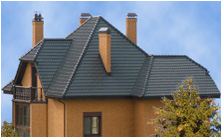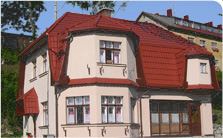Bitumen-polymer materials with metal coating
Under the protection of the metal: bitumen-polymer materials with metal coating
Soft roof with shingles used for more than half a century in Europe and America for almost two decades in Russia, have improved performance. At the same time in the construction market continue to emerge Modified soft roof with new properties, including metallic bitumen-polymer coating. With its unusual decorative properties, they have several advantages in the operation.
Shingles - the material most suitable for roofs of complex shape. It is used when constructing roof membrane in different climatic regions and in the traditional version is composed of bitumen-impregnated one or two layers of fiberglass, asphalt binder layer and has a total thickness of about 3-5 mm. The upper protective layer use different kinds of dressing: slate, ceramic broadcast with (pellets) and painted with high temperature basalt chips.
In the metallic forms of soft roof layer of mineral powder is replaced by a metal foil with a thickness from different manufacturers varies from 50 to 100 microns (depending on the metal). The most commonly used copper or aluminum foil, but there are other coatings. For example, the firm produces Tegola shingles with zinc-titanium or even gold plated.
The range of Siplast-Icopal present bitumen-polymer materials, coated with a thin layer of copper, aluminum and stainless steel. In Russia, this roofing material has not yet submitted.
In addition to soft tile, consisting of individual sheets, also produce roll roofing materials based on bitumen or bitumen-polymer tread compound with a coating of metal foil. The Russian manufacturer - "Ural Plant of bituminous roofing materials in the city Degtyarskoye. As the metallic coating of these materials are also used copper and aluminum foil with thickness of 50-100 microns.
Metallic coating serves to protect the bitumen-polymer mixture and improve the performance of materials. The advantages of foil roofing materials, compared with the traditional, primarily applies to almost one hundred percent protection from ultraviolet and heat radiation (factors, the most destructive impact on bitumen) due to the reflection properties of the foil. Other benefits - reduction of inflammation of roofing material (eg, emitted from a chimney sparks) and increase its strength: foil acts as an additional basis (reinforcing layer). Decrease the load on the roof, since the foil is easier to stone granules. In addition, on the roofs of the foil material is no accumulation of moisture, dust, debris, seed germination of plants and, consequently, the destruction of roof membrane. All of this generally leads to an increase in the life of the roof and improve its performance. Metallized bitumen-polymer coatings, especially with a copper coating, resistant to weather-containing chemically active substance that is needed in urban environments. Wide operating temperature range is important in applications where the Russian climate. So, foiled roofing materials "Ural plant of bituminous roofing materials" remain flexible at -25 ° C, and heat resistance - up to 100-120 ° C (depending on the base material and the type metal). Roofing made from these materials can withstand rain, hail, strong winds, icing and direct sunlight.
As a consequence, optimization of operating parameters increased longevity of the roof with a coating of metal foil. Manufacturing companies offer a guarantee of at least 10-15 years for shingles and 20 years for roll materials. The guarantee is valid if the installation was done in accordance with the instructions on installation and operating conditions of the roof are in the range of valid values (in particular, correspond to climatic zones specified in the documentation).
Bitumen-polymer roofing materials are available with coatings of different metals. The most common is copper on the surface which eventually forms a protective layer, patina that protects the metal from corrosion. The more acid and salts in the atmosphere than the wetter and warmer climate, the faster the oxidation (by the sea - more intense in the middle lane and the north - the duration). Patina, but anti-corrosion metal coating gives additional decorative features. Therefore Tegola, for example, produces copper shingles to have a layer of patina.
Protective film of oxide coated and aluminum foil and zinc-titanium sheet. But if the first golden copper color changes on the chocolate, and a half or two decades, becoming greenish, the aluminum and titanium alloys from oxidation only slightly darken and become opaque.
For those who do not want that in a few years, the house looked like an old mansion, and who like a bright copper color of the roof, the company produces Tegola tiles coated with a layer of colorless nail polish. The thickness of the layer is 70-80 microns. Under his protection the roof will not change color over time, paint is very durable and can withstand all atmospheric effects. The only restriction, which prevents a manufacturer: Avoid mechanical damage to the lacquer layer for the installation and use of sharp and heavy objects (rough soles of shoes, hammers, ladders, etc.), as the site of injury begins the process of oxidation of the metal foil.
Company Siplast-Icopal produces metallic roofing materials coated with paint. It is deposited over the aluminum layer and is in addition to protection from ultraviolet radiation, and even more decorative finish of the roof. Color selection is quite wide: from dark green, dark red and dark gray to a bright - "zinc" and white. There is a color that simulates a copper patina.
Foil materials, as well as traditional bitumen, is produced by bilateral application on the basis of the composition of the bitumen binder, filler and processing aids. At the same time from different manufacturers and manufacturing technology of the bituminous mixture may be slightly different. For example, the firm Tegola used in the manufacture of tile Venezuelan natural bitumen. Who had for many years, contact with oxygen, it differs from the bitumen produced by chemical means stronger molecular bonds and is highly resistant to UV radiation (up to four times greater than that of artificial bitumen) and a flattened response to daily changes in temperature. Natural bitumen in the production process is subjected to artificial aging and impose special additives to give a mixture of high physicomechanical and operational characteristics.
Technology to produce bitumen roofing materials (for example, "Ural plant of bituminous roofing materials) can be roughly described as follows: first, the heated to the desired temperature bitumen injected polymers and produce their mechanical dissolution. Amount of polymer can range from zero (bituminous materials) to 12% (bitumen-polymer materials with improved reliability). Then the mixture was added filler (talkomagnezit, dolomite flour, etc.), it carefully mixed and poured into a special bath. Basis of roofing material (fiberglass, polyester, fiberglass), passing through the bath, collecting over a layer of bitumen-polymer mixture. Layer thickness is regulated gauge rollers on the output.
Most manufacturers base consists of one layer of fiberglass or polyester, but may be combined, two-layer: between two layers of glass has an intermediate layer of bitumen. The reinforcing fibers are needed to increase strength and maintain the dimensional stability of shingle. As an example of bitumen-polymer tiles having two layers of foundation, can cause Shingles Toisite cuivre-coated copper produced Siplast-Icopal. It includes, besides the double-layer glass fiber reinforcement, the inner side has a coating of cork granules, which contributes to more micro-ventilation and sound insulation roofing material. The total thickness of the tile at the same time up to 6 mm.
Metal foil onto the prepared "layered cake" of base and bituminous mixture can be applied in two ways. One of these "hot" when the foil is placed on the molten bitumen-polymer mixture into the production of cloth. Often this method is used in the production of rolled clad material. Its shortcomings - the appearance of small wrinkles in the foil (for the difference in coefficients of thermal expansion of bitumen and copper) and the lack of foil on the sides of roofing material after the cutting of individual pieces of cloth (shingles) for the production of tiles. In the second method of foil glued every single piece (shingle). Then the foil lies flatter and specially bent sideways, closing the ends. As a result, after installing the effect appears monolithic roof.
Manufacturers of foil bituminous coatings do not indicate the specific requirements that must be followed when installing a roof. The special features include the installation of carefully pre-layout, professional execution of work and pre-prepared set of essential accessories: hips, a special rug for the valley, etc.
Installation of metallic tiles is different from traditional styling flexible. Metallic tiles are laid on a solid foundation of smooth water-resistant plywood, oriented chipboard or floorboards, the humidity does not exceed 20%.
As an underlayment for roofing sheets used in roofing carpet rolled bitumen-polymer materials based on polyester. With a slope ramps to 60 ° underlay is laid across the surface of the roof in rows parallel to the eaves, with a longitudinal overlap of 10 cm, cross - 20 cm in slope of the roof slopes greater than 60 ° waterproof membrane is sufficient to lay a valley, on skates and end parts of the roof, along the eaves (with a minimum width of 2 m), around chimneys, vents, skylights, as well as in other places where snow and the probable formation of "ice lens".
Laying tile is made from the middle slope. Products each manufacturer has the nuances of technology installation. In general, the sheets are fixed with nails and screws. The location is closed stacked overlapping subsequent layer.
Roll metallic materials assembled by the traditional method of fusing technology.
Source: Ludmila Luba / uralcc.ru journal "Evolution of the roof» / evoroof.ru





